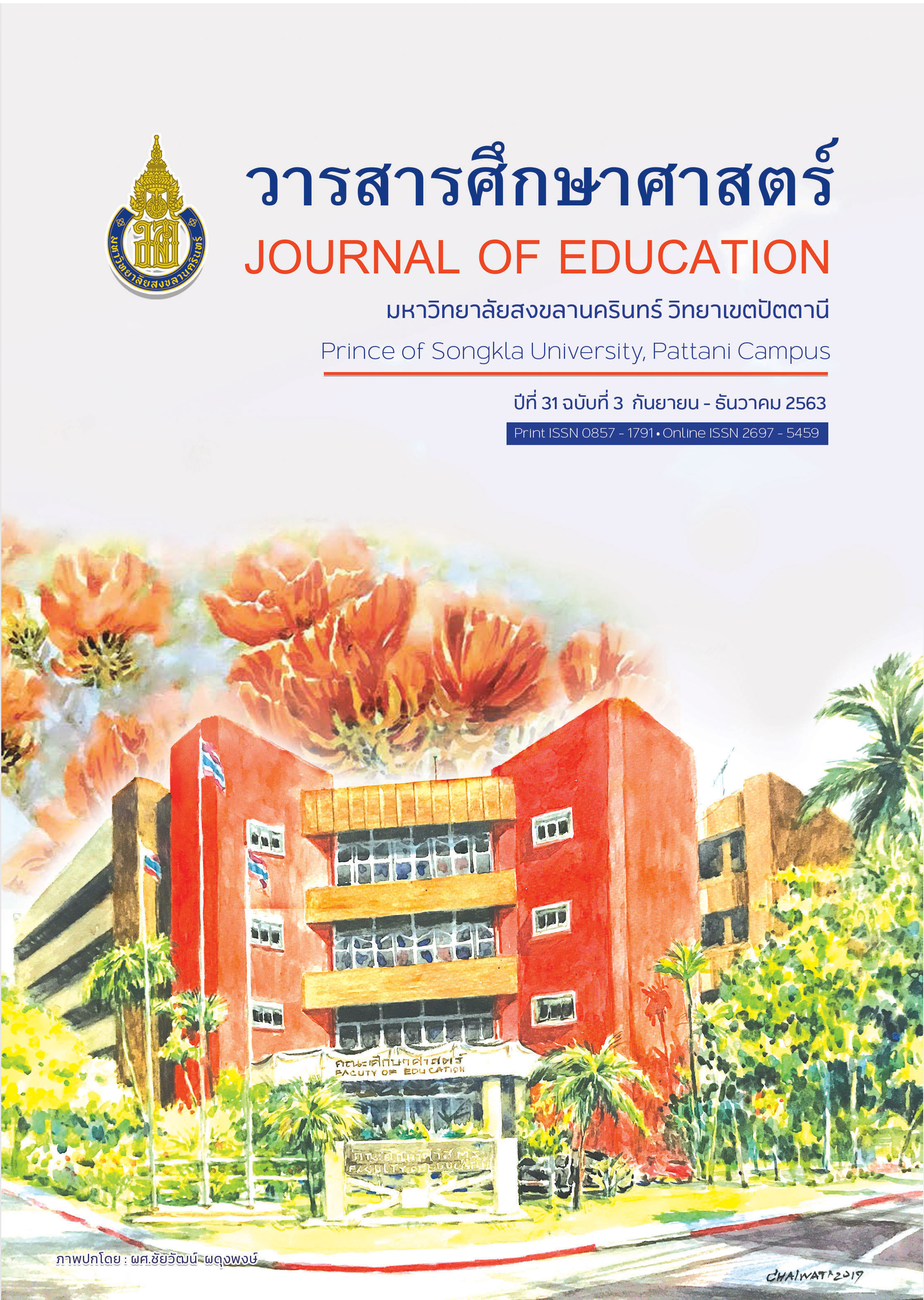การประเมินความสามารถในการอธิบายทางวิทยาศาสตร์ ผ่านปัญหาที่เน้นบริบทของนักศึกษาครูชีววิทยา
Main Article Content
บทคัดย่อ
งานวิจัยนี้มุ่งศึกษาความสัมพันธ์ระหว่างความสามารถในการอธิบายทางวิทยาศาสตร์และมโนทัศน์ทางชีววิทยาของนักศึกษาครูชีววิทยา ผู้วิจัยสร้างแบบสอบวัดความสามารถในการอธิบายทางวิทยาศาสตร์ ซึ่งประกอบด้วยคำถามปลายเปิดที่มีบริบทเกี่ยวข้องกับชีววิทยาในชีวิตประจำวัน จำนวน 10 ข้อ (ค่าความเชื่อมั่น 0.84) และแบบสอบวัดมโนทัศน์ทางชีววิทยาซึ่งประกอบด้วยคำถามปลายเปิดที่มีเนื้อหาสอดคล้องกับเนื้อหาที่ใช้ในแบบวัดความสามารถในการอธิบายทางวิทยาศาสตร์ จำนวน 10 ข้อ (ค่าความเชื่อมั่น 0.78) นำไปใช้เก็บข้อมูลกับนักศึกษาครูชีววิทยา ชั้นปีที่ 4 จำนวน 31 คน ข้อมูลวิจัยพบว่า นักศึกษาครูชีววิทยามีคะแนนเฉลี่ยความสามารถในการอธิบายทางวิทยาศาสตร์ค่อนข้างต่ำ (ร้อยละ 40.33) คะแนนเฉลี่ยความเข้าใจในมโนทัศน์ทางชีววิทยาค่อนข้างสูง (ร้อยละ 73.33) และความสามารถในการอธิบายทางวิทยาศาสตร์และมโนทัศน์ทางชีววิทยาไม่มีความสัมพันธ์กัน
Article Details
เอกสารอ้างอิง
สถาบันส่งเสริมการสอนวิทยาศาสตร์และเทคโนโลยี. (2561). ผลการประเมิน PISA 2015 วิทยาศาสตร์ การอ่าน และคณิตศาสตร์ ความเป็นเลิศ และความเท่าเทียมทางการศึกษา. กรุงเทพฯ: สถาบันส่งเสริมการสอนวิทยาศาสตร์และเทคโนโลยี.
Bell, P., & Linn, M. (2000). Scientific arguments as learning artifacts: Designing for learning from the web with KIE. International Journal of Science Education. 22(8), 797 – 817.
Berland, L. K., & Reiser, B. J. (2008). Making sense of argumentation and explanation. Science Education, 93(1), 1– 30.
Chinn, C. & Brown, D. E. (2000). Learning in science: a comparison of deep and surface approaches. Journal of Research in Science Teaching, 37(2), 109 – 138.
Chinn, C. A., & Brewer, W. F. (2001). Models of data: A theory of how people evaluate data. Cognition and Instruction, 19(3), 323–393.
Enghag, M., Gustafsson, P., & Jonsson, G. (2007). From Everyday Life Experiences to Physics Understanding Occurring in Small Group Work with Context Rich Problems During Introductory Physics Work at University. Research in Science Education, 37(4), 449–467.
Enghag, M., Gustafsson, P., & Jonsson, G.. (2009). Talking physics during small-group work with context-rich problems – analysed from an ownership perspective. International Journal of Science and Mathematics Education, 7(3), 455–472.
Federer, M. R., Nehm, R. H., Opfer, J. E., & Pearl, D. (2014). Using a Constructed-Response Instrument to Explore the Effects of Item Position and Item Features on the Assessment of Students’ Written Scientific Explanations. Research in Science Education, 45(4), 527–553.
Hartmann, S. Upmeier zu Belzen, Dirk, A., Dirk, K. & Pant, H. (2015). Scientific Reasoning in Higher Education. Zeitschrift für Psychologie, 223(1), 47–53.
Jonsson, G., Gustafsson, P., & Enghag, M. (2007). Context rich problems as an educational tool in physics teaching – a case study. Journal of Baltic Science Education, 6(2), 26–34.
Kampourakis, K., Silveira, P. & Strasser, B. J. (2016). How Do Preservice Biology Teachers Explain the Origin of Biological Traits?: A Philosophical Analysis. Science Education, 100(6), 1124–1149.
Kuhn, L., & Reiser, B. (2005). Students constructing and defending evidence-based scientific explanations. Paper presented at the annual meeting of the National Association for Research in Science Teaching, Dallas, TX.
McNeill, K. L. & Krajcik, J. S. (2006). Supporting Students Construction of Scientific Explanation through Generic versus Context-Specific Written Scaffolds. Paper presented at the annual meeting of the American Educational Research Association, San Francisco, April, 2006.
McNeill, K. L. & Krajcik, J. S.. (2008). Scientific explanations: Characterizing and evaluating the effects of teachers' instructional practices on student learning. Journal of Research in Science Teaching, 45(1), 53–78.
McNeill, K. L. & Krajcik, J. S.. (2012). Supporting Grade 5 – 8 Students in Constructing Explanation In Science: The Claim, Evidence, and Reasoning Framework for Talk and Writing. Boston: Pearson Education, Inc.
McNeill, K. L. & Krajcik, J. S.. (in press). Middle school students’ use of appropriate and inappropriate evidence in writing scientific explanations. In M. Lovett & P. Shah (Eds.), Thinking with data: The proceedings of the 33rd Carnegie symposium on cognition. Mahwah, NJ: Lawrence Erlbaum Associates, Inc.
Metz, K. E. (2000). Young children’s inquiry in biology: Building the knowledge bases to empower independent inquiry. In J. Minstrell & E. H. van Zee (Eds.), Inquiry into inquiry learning and teaching in science (pp. 371–404). Washington, DC: American Association for the Advancement of Science.
National Research Council. (1996). National science education standards. Washington, DC: National Academies Press.
Nehm, R. H., Beggrow, E., Opfer, J., & Ha, M. (2012). Reasoning about natural selection: Diagnosing contextual competency using the ACORNS instrument. The American Biology Teacher, 74(2), 92–98.
Ningsi, S., Suhandi, A., Kaniawati, A., & Samsudin A. (2019). Development of scientific explanation skills test instrument. Journal of Physics: Conference Series, 3(1157), 1–6.
OECD. (2016). PISA 2015 Assessment and Analytical Framework: Science, Reading, Mathematic and Financial Literacy. Paris: OECD Publishing. Retrieved from http://dx.doi.org/10.1787/9789264255425-en
Osborne, J., Erduran, S., & Simon, S. (2004). Enhancing the quality of argumentation in school science. Journal of Research in Science Teaching, 41(10), 994-1020.
Osborne, J. F., & Patterson, A. (2011). Scientific argument and explanation: a necessary distinction? Science Education, 95(4), 627–638.
Ruiz-Primo, M., Tsai, S., & Schneider, J. (2010). Testing One Premise of Scientific Inquiry in Science Classrooms: Examining Student, Scientific Explanations and Student Learning. Journal of Research in Science Teaching, 47(5), 583–608.
Sandoval, W. A. & Reiser, B. (1997). Evolving explanations in high school biology. Paper presented at the Annual Meeting of the American Educational Research Association. Chicago, IL.
Sandoval, W. A., Crawford, V., Bienkowski, M., Hurst, K., & Millwood, K. (2004). Effects of explanation support on learning genetics. Retrieved from http://citeseerx.ist.psu.edu/viewdoc/download doi=10.1.1.80.8436&rep=rep1&type=pdf
Sadler, T. (2004). Informal reasoning regarding socioscientific issues: A critical review of the research. Journal of Research in Science Teaching, 41(5), 513–536.
Sampson, V., & Clark, D. (2009). The impact of collaboration on the outcomes of scientific argumentation. Science Education, 93(3), 448–484.
Sesen, B. A. (2013). Diagnosing pre-service science teachers' understanding of chemistry concepts by using computer-mediated predict–observe–explain tasks. Chemistry Education Research and Practice, 14(3), 239-246.
Tang, K. S. (2016). Constructing scientific explanations through premise–reasoning–outcome (PRO): an exploratory study to scaffold students in structuring written explanations. International Journal of Science Education, 38(9), 1415–1440.
Yang, H. T. & Wang, K. H. (2013). A Teaching Model for Scaffolding 4th Grade Students’ Scientific Explanation Writing. Research in Science Education, 44(4), 531–548.
Zimmerman, C. (2000). The development of scientific reasoning skills. Journal of Research in Science Teaching, 20(1), 9–149.


